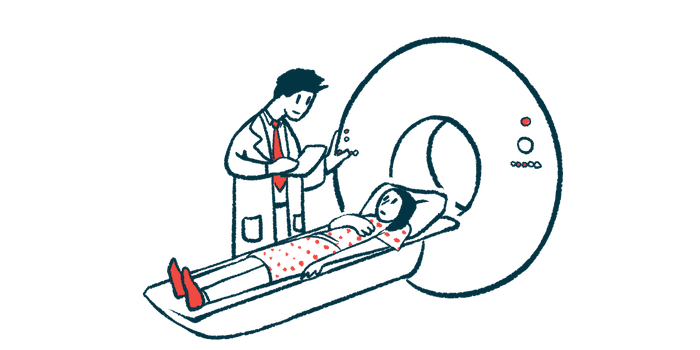Noninvasive quantitative MRI detects Gb3 in Fabry brains
Technique called a new tool to monitor tissue damage, treatment response
Written by |

Noninvasive quantitative magnetic resonance imaging, or qMRI, accurately detected excess globotriaosylceramide (Gb3), the fatty molecule that accumulates in people with Fabry disease, in the brains of people with the disease, a study reports.
“We demonstrated the feasibility and clinical relevance of noninvasively assessing cerebral Gb3 accumulation in [Fabry] using MRI,” the researchers wrote in “In vivo demonstration of globotriaosylceramide brain accumulation in Fabry Disease using MR Relaxometry,” a study published in Neuroradiology. They hailed their findings as “a novel tool to monitor tissue damage progression and treatment response.”
Alpha-galactosidase A (alpha-Gal A) is an enzyme that breaks down fat-like lipid molecules, mainly Gb3 (or Gl-3), into building blocks cells can use.
In Fabry disease, alpha-Gal A is either absent or dysfunctional, leading Gb3 to build up to toxic levels, causing damage to multiple tissues and organs, most often the kidneys, heart, and central nervous system (CNS), which is made up of the brain and spinal cord.
A qMRI can measure the buildup of substances in the brain, including iron and lipids. It generates R1 maps that reflect the relaxation rate of water molecules in a specific tissue. R1 values are influenced by the presence and concentration of certain substances, such as iron and lipids. Higher R1 values generally indicate a faster relaxation rate and may be associated with increased levels of these substances in the tissue.
A new measure of Gb3 in Fabry disease
A research team in Italy used qMRI to measure Gb3’s buildup in Fabry patients’ brains. Their goal was to expand “the current knowledge about the [physiology] of brain damage in this condition and provide a tool to monitor brain disease progression and treatment efficacy.” A qMRI was applied to 42 Fabry disease patients (mean age, 42.4) and 49 age- and sex-matched healthy people who served as controls. Sixteen patients were men and 26 were women.
Fabry patients had slightly higher R1 values than controls for both gray matter and white matter in the brain. Gray matter is made up of nerve cell bodies, while white matter consists primarily of nerve fibers coated in fatty myelin.
Although patients had higher R1 values than controls, the differences were statistically insignificant. There were also no differences in magnetic susceptibility, which provides information about the composition and structure of tissues, such as the presence of iron deposits or other substances that alter a tissue’s magnetic properties.
But there were widespread differences between patients and controls following a voxel-wise analysis, which examines brain tissue in fine detail. A voxel is the 3D equivalent of a pixel in a 3D image.
Increased R1 values were found in several clusters in various gray matter structures. Changes in white matter, which were more distributed across tissues, were also seen.
No differences emerged when analyzing quantitative susceptibility mapping (QSM), a technique for measuring iron buildup. The findings excluded the possible “contribution of iron modifications … indirectly confirming that the observed R1 changes were mainly a reflection of lipid accumulation,” the researchers wrote.
When qMRI results were compared with clinical data, no significant correlations were observed between the clusters of increased R1 values and the Fabry Stabilization index (FASTEX), which assess disease stability and progression in Fabry. Still, low levels of residual alpha-Gal A enzyme activity in the blood significantly correlated with increased R1 values in gray and white matter.
“We demonstrated that the noninvasive assessment of cerebral Gb3 accumulation in [Fabry] using MRI is both feasible and clinically relevant,” the researchers said. “R1 mapping might be used as an in vivo quantitative neuroimaging marker of Gb3 deposition in [Fabry] patients.”



